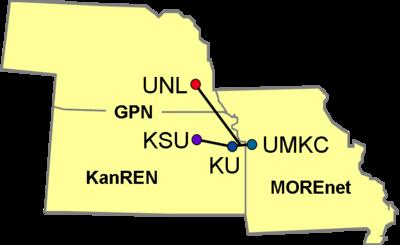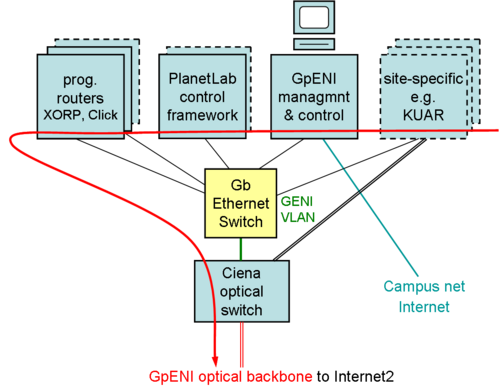Research Interests
- Optical Networks
- Software Defined Networking (SDN) and Network Functions Virtualization (NFV)
- Future Internet Architectures including Content Centric Networking (CCN)
- Network Security
Current Projects
-
MobilityFirst: A Robust and Trustworthy Mobility-Centric Architecture for the Future Internet (funded
by the US National Science Foundation - NSF) (2010-2013) (Partners are Rutgers (Lead), U. Mass-Amherst, MIT, U. Wisconsin- Madison, UNC, Duke, U. Michigan, and U. Mass-Lowell)
The MobilityFirst project is founded on the premise that the Internet
is approaching an historic inflection point, with mobile platforms and
applications poised to replace the fixed-host/server model that has
dominated the Internet since its inception. This predictable, yet
fundamental, shift presents a unique opportunity to design a next
generation Internet in which mobile devices, and applications, and the
consequent changes in service, trustworthiness, and management are
primary drivers of a new architecture. The major design goals of our
proposed architecture are: mobility as the norm with dynamic host and
network mobility at scale; robustness with respect to intrinsic
properties of wireless medium; trustworthiness in the form of enhanced
security and privacy for both mobile networks and wired
infrastructure; usability features such as support for context-aware
pervasive mobile services, evolvable network services, manageability
and economic viability. The design is also informed by technology
factors such as radio spectrum scarcity, wired bandwidth abundance,
continuing Moore's law improvements to computing, and energy
constraints in mobile and sensor devices.
The UNL team (led by Byrav Ramamurthy) will study the impact of the rising number of mobile users on the Internet core, which consists of a fiber-optic network. In addition, UNL researchers will contribute to the overall design and evaluation of the MobilityFirst Future Internet architecture.
-
Dynamic Optimized Advance Scheduling of Bandwidth Demands
for Large-scale Science Applications (funded
by the US Department of Energy - DOE) (2009-2012)
In this project, we propose to enhance the capability of the
DoE's ESnet by providing dynamic, optimized, advance
scheduling of bandwidth demands required by large-scale science
applications.
-
Architectures for P2P Live Streaming
In the area of peer-to-peer computing,
we are investigating efficient techniques for supporting large-scale multimedia streaming
over such networks. Such applications will enable
large-scale deployments of high-bandwidth optical and wireless access
networks, making ubiquitous broadband a reality.
-
Great Plains Environment for Network Innovations (GpENI) (funded
by the US National Science Foundation - NSF GENI initiative through BBN) (website)
The Great Plains Environment for Network Innovation - GpENI is a regional network between The University of Kansas (KU), Kansas State University (KSU), University of Nebraska - Lincoln (UNL), and University of Missouri - Kansas City within the Great Plains Network, supported with optical switches from Ciena interconnected by Qwest fiber infrastructure, in collaboration with the Kansas Research and Education Network (KanREN) and Missouri Research and Education Network. GpENI is undergoing significant expansion to Europe and Asia using various tunneling protocols. GpENI is funded in part by the National Science Foundation GENI (Global Environment for Network Innovations) Program, as well as by the participating institutions that are contributing substantial resources. To run a demo on the GpENI network, please visit here.


-
Multimedia Communications Over Interplanetary Networks (Funded by NASA, through the
NASA Nebraska Space Grant
In this project, we will develop techniques to improve the data
transfer speeds for multimedia data over NASA's space networks. The project
involves collaboration between researchers at UNL CSE department and NASA
Jet Propulsion Laboratory (JPL).
-
Multi-layer Survivable Telecommunication Networks (funded by AT&T through the Virtual University
Research Initiative (VURI) program)
While failure detection can happen quickly at the optical layer, the recovery (restoration) is slow and hard at the IP layer. Moreover, a single failure event at lower layer cascades into multiple failure events at the IP layer. Developing efficient cross-layer mechanisms for IP layer restoration after network failures is the focus of this work.
Recent Projects
-
Groundwater monitoring sensor network project in Nebraska (funded
by the US Department of Agriculture - USDA) (website)
This project aims to develop a real-time groundwater-level monitoring network in Nebraska to provide fast and reliable data that will support agricultural decision-makers and other groundwater users to better plan for, recognize, deal with, and document multiple-year droughts.
A framework for remote telemetry using smart sensors and wireless telecommunication technology is being designed and implemented to collect and analyze groundwater hydrologic information from over 50 sites around Nebraska. Observation wells will be primarily chosen for their ability to detect the onset, magnitude and recovery of hydrological drought.
The architecture of the proposed framework consists of three main components: data acquisition unit, data transfer unit and data processing unit.

Data acquisition unit consists of a traditional water monitoring transducer and an embedded system. The embedded system does preliminary signal processing and packs the hydrologic data collected by the transducer into a proper and secure format ready for remote transmission. Data transfer unit consists of a satellite transceiver module or an cellular communication module, both of which will guarantees the reliable telecommunication with minimum expense. Both data acquisition unit and data transfer unit are powered by a solar panel and battery. All the hydrologic data will be collected hourly and transmitted daily to a central base station. Adjustments in the frequency of measurements and reporting can be made if a site is experiencing significant changes in water level or if future research investigations require more frequent measurements. A data processing unit, with a friendly Graphical interface, is located at the base station to analysis and archive the real-time data.
Information produced through this network could be utilized to address the effects of multiple-year drought in Nebraska and increase the economic and production stability of agricultural producers. The network also can be easily adapted to other fields of environmental monitoring.
Publications
|
| 


